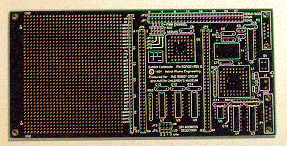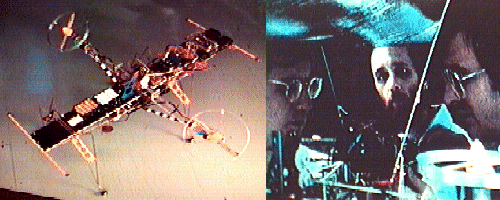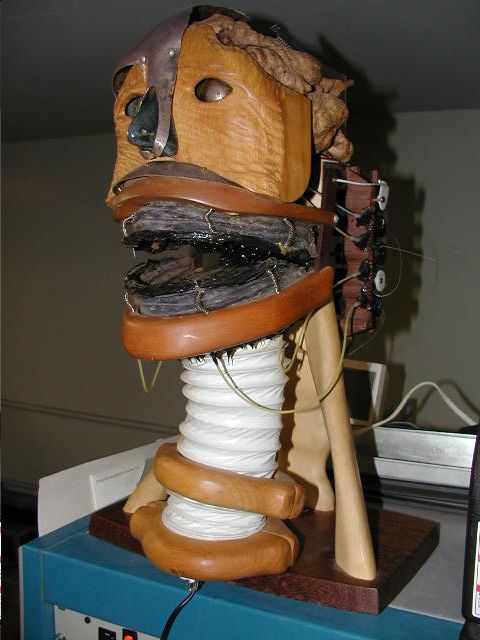The Mark IV Cybernetic Airship, aka Mark IV Neural Net Scanning SONAR Blimp was next in the evolution of the blimp projects.
Craig Sainsott designed and built the blimp under carriage. Alex Iles and Bill Craig were responsible for the electronic and computer implementation. John Lovgren developed the neural network learning program. Brooks Coleman was the training pilot. Read more of the technical details on blimps.
Tag: Alex Iles
Exhibit Controller Board
Another effort of The Robot Group has been to develop a multi-purpose microcontroller system appropriate for controlling motors, sensors, and other devices.
Connected together in a network, groups of these systems can be controlled via a higher level central computer. This can be used to control complex robotics systems and can produce striking behavior of museum exhibits, and information about exhibit behavior and crown activity and interaction from one exhibit to the next.
The Exhibit Controller Board was initially designed as part of the Berzerkwerks (Aug. ’91) exhibit at Austin’s Children’s Museum and subsequently has been used in several Robot Group projects.
It incorporates a methodology to allow the onboard Motorola MC68HC11E9 microcontroller to control up to 28 servo motors. Each system provides connection for a Motorola MC68332BCC, a small but powerful MC68332-based computer system, which may act locally or serve as the master controller for up to 14 other systems.

Alex Iles designed the hardware and the software for servo control. He later revised the design to incorporate MIDI communications and to reduce the size of the circuit board.
Bill Craig developed a real-time distributed operating system allowing the network of exhibit controllers to operate at its full potential. The operating system runs on a Motorola MC68332BCC (which acts as the central controller) mounted on one of the networked boards.
Projects incorporating the exhibit controller include Big Rock Robotic Tower, Sparky, the Robotic Pup, and the Tai Chi Dancers (a moving sculpture consisting of choreographed robotic arms, which utilizes a network of controllers and the distributed operating system).
Outreach : Space Shuttle Simulator
Throughout its history, The Robot Group’s outreach program at area primary schools has been a key activity. “Robots, Gadgets and Gizmos,” a demonstration of robot construction using common household materials, was regularly presented to grade school children identified as “at-risk” and disadvantaged.
One long-term project, the Space Shuttle simulator at Kealing Junior High (since renamed Kealing Middle School), stands above the rest. Science students learned about mechanics and computer control by constructing robot arms used in their final semester projects.
This project was under the direction of Robot Group member, Linda Brown. She was ably-assisted by Alex Iles, Brooks Coleman, and Bill Craig.
Group members also assisted Kealing students by supplying robotic arms and telepresence equipment.

This Space Shuttle mock-up, featuring a large robotic manipulator-arm constructed by the students from salvage, appeared at the Cyberspace Convention (1990) and at several RoboFests. The students used the simulator to “fly” missions and accomplish tasks such as rescuing satellites and performing experiments. During these simulated missions, the ground crews communicated with the flight crew via computer terminals and video cameras.
Babbling Head
The Babbling Head Robot, better known as Babbling Head is one of The Robot Group’s iconic exhibits.
Babbling Robot Head is perhaps one of the finest examples of our group’s efforts to meld art and technology. It is certainly one of the classiest. Brooks Coleman, a genius at wood-crafting, designed and crafted the various wood elements that went into this piece. These wood elements are as diverse and as rich as purple heart and oak and as raw as tanzania root.
The base of the piece is purple heart wood and the neck and collar bones are pow amavia woods. The organic brain in this robot is a piece a tanzania root that Brooks filed and fitted perfectly to this piece.
The rawness and natural ridges of the wood root give it a very natural organic-looking brain.
Brooks, who also does metal forging, tailored the metal nose and half head piece for Babbling Head while Laurie Davis forged the eyes.
The eyeballs are hammered silver with LEDs illuminating the iris centers. The eyeballs are also servo-controlled and capable of rolling.
The neck and the lips are made of soft plastic for mobility. The lips are molded black silicone and the neck-pipe piece is actually a dryer vent pipe.
The servos are each fitted with a winch pulley which Brooks turned from nylon. He machined a custom tool to create the spline that fits the standard Futaba servo shaft.
This robot is fitted with a Mini SSC II board that operates a series of hobby servo motors that move the lips, eyeballs and neck areas.
The DecTalk provides the computer voice that brings the Babbling Robot Head to life.
Alex Iles was instrumental in developing and programming the original exhibit controller for this piece. Bill Craig assisted with the original programming and the speech synthesis. Later, Eric Lundquist added real-time speech synchronization with the DecTalk.
At times, Babbling Head has been integrated into the Robot Brain project.
When last it spoke, Babbling Head revealed that it was awaiting some surgery. We look forward to its reappearance and to hearing it sing again.
Did we mention Babbling Head’s popularity? Some notable appearances :
- 2007-03 dorkbot / SxSW Festival (covered by BBC News)
- 2004-07 1st Annual CAM Carnival, San Antonio, TX
- 2003-08 Film debut in Armadillo News
- 2003-07 Comedy Central’s Insomniac with Dave Attell
[Text and images originally from http://wiki.therobotgroup.org/wiki/BabblingHead


